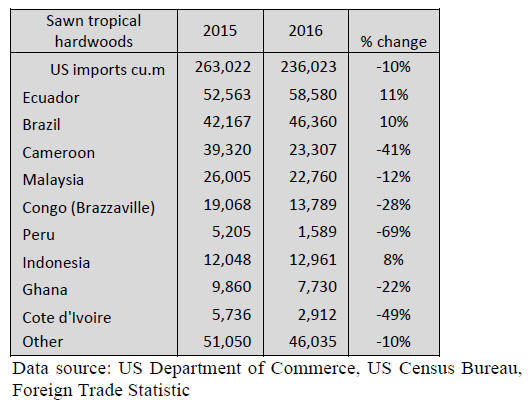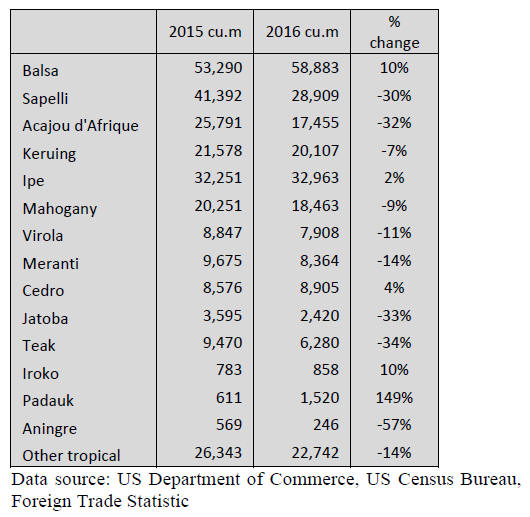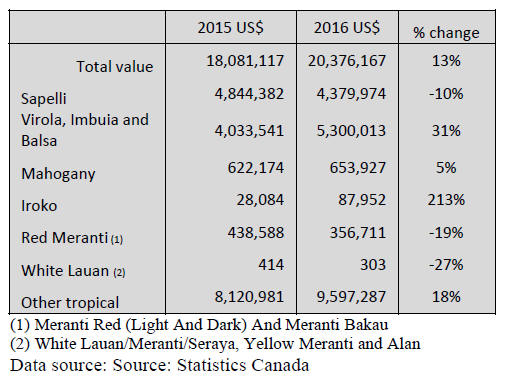|
Report from
North America
Ipe tops sawnwood imports by value but balsa top by
volume
Annual imports of temperate and tropical sawn hardwood
decreased 15% in 2016 from the previous year. However,
despite economic growth and a stronger housing market
hardwood imports were 961,733 cu.m. in 2016, down
from over 1.1 million cu.m. in 2015. The value of imports
declined 8% in 2016 to US$481.9 million.
Imports of most hardwood species decreased in 2016, with
the exception of temperate species white oak and western
red alder, which grew by over 50% from 2015.

At 236,023 cu.m. tropical sawnwood imports declined
10% in 2016. The value of tropical imports decreased 13%
from 2015 to US$251.3 million. The share of tropical
sawnwood in the total value of US hardwood imports was
52% in 2016, down from 55% in 2015.

Imports of balsa, ipe, cedro, iroko and padauk sawnwood
grew in 2016, while most other species declined. Balsa
was the most significant imported species by volume
(58,883 cu.m.), up 10% from 2015.
Ipe was the most valuable import in 2016 at US$64.9
million, followed by balsa, sapelli and teak.
Sapelli sawnwood imports fell 30% in 2016 to 28,909
cu.m. Imports of acajou d¡¯Afrique, teak and jatoba were
also down by about one third from 2015. Keruing and
mahogany imports declined by 7% and 9%, respectively,
from the previous year.
Tropical sawnwood imports from Brazil and Ecuador grew
in 2016, due to higher ipe and balsa shipments. Imports
from most other countries declined compared to 2015,
with the exception of Indonesia. Indonesia increased
exports to the US by 8% in 2016, mainly in ¡®other¡¯
tropical species that are not specified in the trade
classification system.
Canadian tropical sawnwood imports firmed in 2016
Canadian imports of tropical sawnwood increased in 2016
despite a drop in imports at the end of the year. 2016
imports were worth US$20.4 million (US dollars), up 13%
from 2015.
Imports of virola, imbuia and balsa (combined) grew 31%
in 2016 to US$5.3 million. The majority of this growth
was in higher balsa sawnwood imports.
Sapelli sawnwood imports declined 10% in 2016 but at
US$4.3 million sapelli still represented a significant
portion of tropical imports. Imports of mahogany
sawnwood grew 5% to just under US$0.7 million.
Most exporters of tropical sawnwood to Canada increased
shipments in 2016 with the exception of Congo (former
Brazzaville), Ghana and Bolivia. Lower sapelli imports in
particular affected imports from Africa.
The strongest growth from 2015 was in imports via the
US, which increased 73% to US$1.7 million in 2016.

¡¡
Suspension of published Federal Regulations
The Trump administration issued an order on January 20
directing all Federal agencies to suspend for 60 days the
effective dates of rules that have been published in the
Federal Register but have not yet taken effect.
This order opens the door to blocking rules that the
Environmental Protection Agency issued in the final
weeks of the previous Obama administration, including
the formaldehyde emission rule. Potentially rules could be
withdrawn entirely, withdrawn for further review, or they
will be allowed to take effect without changes.
Growth in furniture orders, shipments and retail sales
New furniture orders increased 8% in November 2016
from the same time last year, according to the Smith
Leonhard industry survey of residential furniture
manufacturers and distributors. This followed a 1%
increase reported in October. Over 60% of survey
participants reported order gains in November.
Year-to-date new orders were up 3% compared to the
same period in 2015. Year-to-date furniture shipments
increased 6% from November 2015. Inventory levels at
distributors and manufacturers were unchanged from
October and slightly down from November 2015.
Strong consumer confidence provided a boost to retail
sales. Annual retail sales at furniture and home furnishings
stores increased 3.8% in 2016 from the previous year,
according to the US Department of Commerce.
Cabinet sales increased in 2016
Cabinet sales increased 4.3% in 2016, according to the
Kitchen Cabinet Manufacturers Association (KCMA)¡¯s
latest Trend of Business Survey. Participating cabinet
manufacturers reported sales totaling US$6.8 billion for
2016, up 4.3% compared to 2015.
Survey participants include stock, semi-custom, and
custom companies whose combined sales represent
approximately 70% of the US kitchen cabinet and bath
vanity market. Stock cabinet sales increased +4% in 2016,
semi-custom sales increased +5.9%, and custom sales
increased +1.3% compared to 2015.
Furniture and cabinet makers expanding production
capacity
La-Z-Boy announced an investment of approximately
US$26 million over three years in its largest upholstered
furniture manufacturing plant in the US. The investment
includes a new innovation centre, various renovations and
technology upgrades, and a new transportation terminal.
Other US furniture and cabinet manufacturers have
announced expansion or investment plans, including
cabinet hardware supplier Blum who will invest US$16
million in upgrades at its headquarters in North Carolina.
MasterBrand Cabinets has announced it will grow its
workforce at its plants in Indiana.
Strong opposition to suggestion of border tax
Many US companies oppose introducing border taxes as
suggested by the Trump administration, and specifically a
20% tax on imports from Mexico.
A new coalition of companies and trade associations,
Americans for Affordable Products (AAP), has formed in
response to the proposed border adjustment tax. The group
argues that the tax will significantly hurt American
consumers.
Home furnishing retailers and associations that have
signed on to the AAP include the Home Furnishings
Association, IKEA North America, International Wood
Products Association, Raymour & Flanigan Furniture, and
Walmart.
|